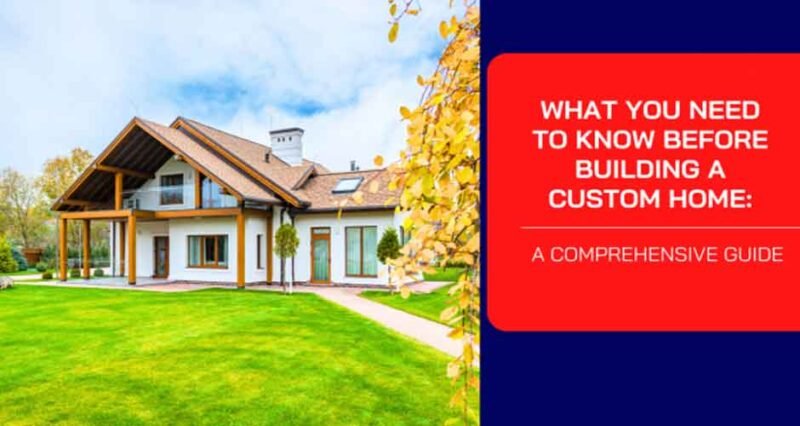
Imagine it – strolling through the entryway of your brand new custom abode. You designed every inch of this home for your lifestyle. The layout flows seamlessly from the media room to the gourmet kitchen. Upstairs, the spa-like master suite provides an oasis of calm. This is your vision come to life.
Building a custom residence offers the tantalizing opportunity to create a personalized sanctuary. However, embarking on a ground-up build involves a complex process that requires strategic planning.
Lay the Financial Groundwork
Building a custom home requires significant financial resources. While exact costs vary widely based on factors like size, location and finishes, typical construction runs $150-$500 per square foot. For a 2,500-square-foot house, you may spend $500,000 to $1.25 million to build a custom home.
When budgeting, obtain estimates from several builders to gauge price ranges. Pad estimates with a 10-20% contingency for overages. Also, account for furnishings, landscaping, appliances, and more. Watch for hidden costs that buyers overlook like permits, exterior lighting and window treatments.
You’ll likely need to finance construction through either a construction loan or a traditional mortgage along with your own cash reserves. A construction loan only charges interest on disbursed funds, avoiding payments on the full amount before you build.
These specialized loans offer flexibility but necessitate refinancing into permanent mortgages upon completion. Traditional home loans offer long-term fixed rates but demand substantial down payments. Get pre-approved early and seek lenders experienced with custom projects.
Select the Perfect Property
Selecting the right lot sets the stage for the entire project. Location and neighborhood preferences may steer your search. Then examine factors like acreage, views, terrain and drainage. Optimal lots have accessible utilities, minimal permitting restrictions and soils suitable for foundations.
Retain an agent well-versed in land deals to identify promising parcels. Verify your floor plan and home footprint fit within setbacks and easements too. Don’t finalize purchasing until fully satisfied the property accommodates your grand vision.
Craft the Designs
In the U.S., if you reside in states like Colorado, addressing specific geographical challenges becomes crucial when crafting a unique residence. Tackling issues like maximizing natural light in the mountainous terrain, conceptualizing open spaces to embrace panoramic views, and seamlessly integrating sustainable features can be daunting without professional expertise. This is where a Custom Home Builder in Colorado Springs plays a crucial role. Collaborating with seasoned architects and designers ensures that challenges unique to the region are met with innovative solutions, resulting in a home that perfectly aligns with the client’s vision and lifestyle preferences.
Achieving an ideal layout, selecting essential amenities, and implementing energy-efficient features such as solar power, spray foam insulation, and radiant floor heating becomes a complex task without specialized guidance. They excel in harnessing natural light by strategically positioning windows and optimizing layouts for an open, interconnected feel.
The expertise of a home builder ensures seamless integration of smart home technology, offering convenience and efficiency. Moreover, these builders expertly incorporate energy-saving elements like solar power, insulation, and radiant floor heating. Their precision in planning and executing these features reduces utility costs, enhancing sustainability.
Assemble Your Building Team
The right contractor makes all the difference for a smooth, successful build. Thoroughly vet potential builders. Examine their custom home portfolios and visit current job sites. Opt for full-service general contractors rather than less experienced niche subcontractors.
Verify licensing, insurance and bonding. Check reputations through references. Interview contractors in detail about their capabilities. Clarify proposed rates, material allowances, change order policies and more within a comprehensive contract.
Decline lowball bids that seem too good to be true. For specialty elements like stonework or media rooms, rely on qualified subcontractors with proven expertise. But have your general contractor manage all scheduling and coordination.
Embrace the Construction Adventure
Once shovels hit the dirt, brace yourself for an exciting rollercoaster lasting up to a year depending on size and intricacy. Construction is intensive, messy work transforming raw land into your homestead. Expect noise, dust, mud and material deliveries.
Your contractor should provide regular updates and oversight to keep the project on schedule and budget. Schedule frequent walk-throughs to inspect progress and ask questions in person.
Despite the best-laid plans, changes and delays can occur. Backorders for appliances or trusses, weather damage and labor issues can slow momentum. Maintain patience, communication, and a problem-solving attitude.
Add Your Personal Stamp
You’re nearing the finish line when it’s time to incorporate custom finishes and décor. Collaborate with interior designers to select lighting, tiling, cabinetry and trims that reflect your lifestyle and taste. Complement with paint colors, window coverings and furnishings. Take time decorating each room – this is your opportunity to personalize by following or bucking trends.
Upgrade with smart home technology like home automation, distributed audio and networked security. The furnishings and finishing touches you choose will complete your home.
Plan Your Move
In the final weeks, excitement builds for move-in day. First, arrange your final builder walk-through and punch list to address any remaining fit and finish items. Once you are satisfied, obtain a certificate of occupancy from your municipality indicating that the home meets all codes.
Schedule utility connections and any security, A/V or IT installation services. Carefully orchestrate the packing and moving process to ease transition into your new abode.
Though demanding at times, the payoff of enjoying a custom residence designed just for you makes the journey worthwhile. By following this guide, you can create your dream home with eyes wide open. Cheers to settling happily into your new, coveted castle and creating lasting memories for years to come!
FAQs
- What are the main factors that determine the cost per square foot for custom home construction?
The cost per square foot depends heavily on the quality of finishes and materials selected, amount of customization, roof and foundation complexity, and geographic location which impacts labor and material costs. High-end finishes like imported tiles, intricate stonework, and premium appliances increase costs.
- What should I look for when selecting a lot for my custom home?
Ideal lots have space to accommodate your planned home size, optimal topography without excessive grading needed, available utility hookups nearby, proper zoning, minimal easements or setbacks, and soils suitable for foundations. Hire professionals to evaluate drainage, infrastructure, permitting restrictions and other lot details.
- How can I ensure my custom home incorporates energy efficiency and sustainability?
Work with your architect to include ENERGY STAR appliances, LED lighting, triple-pane windows, precision insulation, solar panels or wind energy, radiant floor heating, recycled or responsibly sourced materials, low-flow plumbing fixtures, and smart home technology for energy monitoring.


